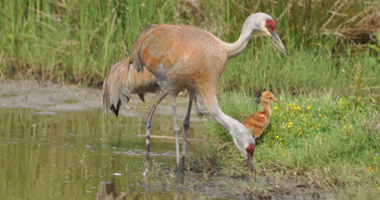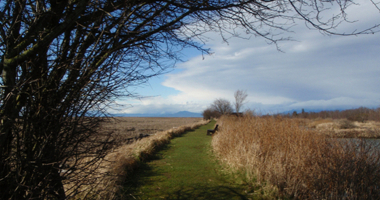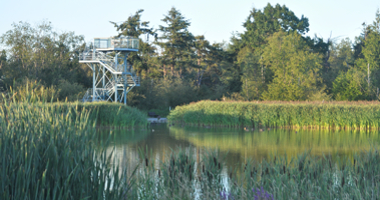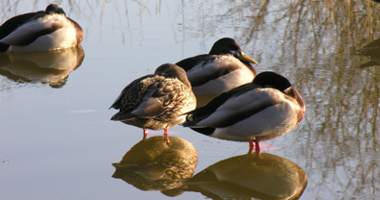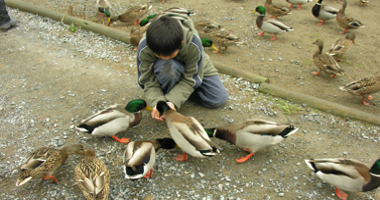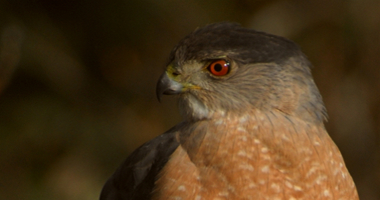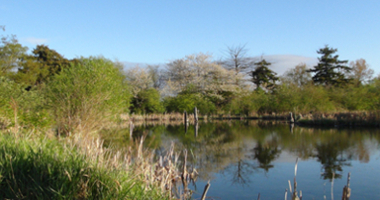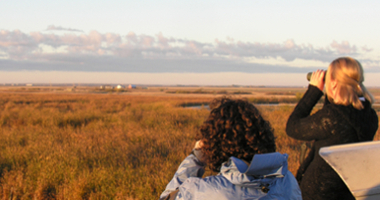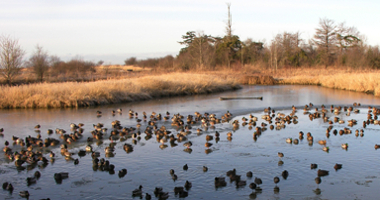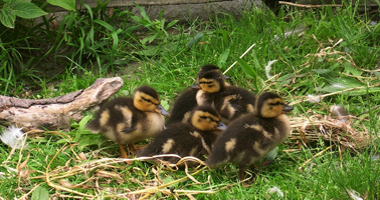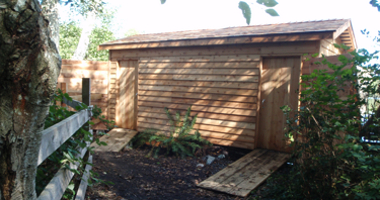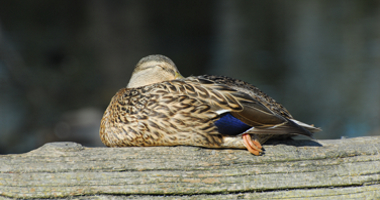School Programs
The British Columbia Waterfowl Society school programs are delivered to up to 5,000 students a year. Note that everyone thinking of bringing a group here for a program should either call our office 604-946-6980 or email our education program staff dani@reifelbirdsanctuary.com at least 2 weeks ahead of time. Your group will then be fitted into the Sanctuary's schedule and we can help allocate parking spots on your behalf and schedule one of our biologists to lead the tour. We only accept one morning and one afternoon group per day and a guide to help with your program is free.
Preschool and Day Care Center Visits
We do not do program tours for children below Kindergarten age, but welcome their visits. Please phone ahead of time to let us know you are coming, and ask for tips on how to prepare your group and if there are any new handouts for this age group.
Self-guided Groups
We prefer that teachers book the formal Sanctuary programs (below) and register ahead of time to get their date of choice, and a staff tour guide. However, sometimes classes end up considering a self-guided tour for various reasons. As long as the students are supervised and activities are suitable for the curriculum and do not ignore the Sanctuary rules, this is acceptable. Self-guided groups do not get access to the Museum, but we will reserve parking spots for your group. Please phone ahead to discuss the dates and times you are considering, so that we can place you in the overall schedule on a day when there are not too many other students or visitors already using our facilities.
Formal Sanctuary Programs
Sanctuary programs require pre-registration two weeks ahead of time to reserve a time slot, staff guides and adequate parking for your class. Signing up for a program provides your class with access to the Lecture Hall and its Museum collections, and a staff biologist to provide a guided walk. Note we take only one class at a time, and some seasons such as October/Novermber and April/May are booked early in the season so call well ahead of time to reserve your date. At the time of booking, we will need to know what your parking needs will be (ie a bus or parent drivers), and will reserve spots on your behalf. See the following general outlines for different age groups.
K-2 Fall Wetland Explorations
These studies also require pre-registration to reserve a time slot and staff assistance. This program is designed for the young visitors (Kindergarten up to Grade 2). Children will be provided with a one-hour group tour of the Sanctuary wetlands and trails, exploring the importance of water under the guidance of our biologist. At the discretion of the leader and teacher, this may be extended to 1.5 hours. The Sanctuary is a colourful place to visit in the fall to learn about our friendly ducks and chickadees, fascinating spiders and other waterbirds and wildlife. Visit our Resource Page for the series of resource booklets to help explore different themes before and after your visit.
K-2 Spring Wetland Explorations
These studies also require pre-registration to reserve a time slot and staff assistance.This program is designed for the young visitors (pre-school and kindergarten up to Grade 2). Children will be provided with a one-hour group tour of the Sanctuary wetlands, exploring nature under the guidance of our biologist. At the discretion of the leader and teacher, this may be extended to 1.5 hours.The Sanctuary is a noisy place in the spring, with birds getting ready for migration, nesting or in the process of building nests. Children will learn about bird behavior, the process of building nests and how we need to be careful not to disturb the birds during this important process.Visit our Resource Page for the series of resource booklets to help explore different themes before and after your visit.
Grades 4-7 Exploring the Sanctuary
These studies also require pre-registration to reserve a time slot and staff assistance. Programs for this age group are 1.5 hours long and include a short orientation session in our Lecture Hall with its museum collections, followed by a 1 hr biologist-led walk, during which students will learn some bird identification and the importance of the Sanctuary's biodiversity to migratory birds and other wildlife. The Sanctuary is located in the Fraser River estuary, and trails meader between large treed areas, open ponds and natural tidal mudflats and wetlands. Seasonal highlights in the fall include the arrival of the Lesser Snow Geese from Russia. Winter highlights often include owls and the very friendly Black-capped Chickadees. In spring, the emphasis is on spring migrants and nesting behavior. Learn about the diversity of local wildlife and habitats by exploring the trails and viewing the estuary from the observation tower. Guides discuss the importance of the estuary and the role of the Sanctuary, bird identification, wildlife needs and habitats, and special terms used. Students should be suitably dressed for the weather, as most of this 1.5 hour program is outside. This program is adjusted for different grades and can includes themes such as the migration of birds, winter survival, habitats and communities, and animal life cycles. Note we only take one class at a time. Visit our Resource Page for the series of resource booklets to help explore different themes before and after your visit.
Migration Studies- These studies also require pre-registration to reserve a time slot and staff assistance. This program is more suitable for middle and secondary grade students. Learn about how researchers census and manage migratory bird populations across North America, and how wildlife habitat is protected. Students practice survey techniques,waterfowl identification and the use of classification keys. During this fall program designed for secondary grades, students will be introduced to the methodology of bird surveys, bird banding and how scientists have learned the migration routes of different species. The Lesser Snow Goose population and the conservation and management of the Sanctuary habitat will be explored as examples of the outcomes of bird studies. The students will then be given a tour of the Sanctuary, with an emphasis on viewing large flocks of migratory birds with binoculars and data sheets.Visit our Resources Page and our Links page for more information on migration, migratory birds and global conservation initiatives.
Specialty Presentations for Secondary, College and University Classes-
As with the above,call ahead to book a time slot and to obtain a staff leader to take student through a more technical program about conservation and management. At the time of booking, please indicate which subject the class is taking. Our staff are versatile, and can help focus your students on themes that address Biology, Social Studies and Geography curriculum topics or Conservation and Resource Management as long as it is pertinent to the management of the Sanctuary.
Work experience
placements are available for a limited number of students each year. Enquire at the Gift Shop about opportunities.
Likely program topics that link to BC Curriculum:
K-1 Exploring plants and animals and how they differ; what are their basic needs; what happens throughout the year to them and how do they survive.
2: Life cycle of animals; How they grow and change; Metamorphosis; Wetland and water characteristics at the Fraser River estuary and it works for plants and animals; Emphasis on need for wetlands and water.
3 Diversity of local plants and animals; food web concepts, and how parts of ecosystem work together; relationships between specific plants and animals and certain habitats of the Sanctuary.
4 Ways that animals sense the world; adaptations for noctural lives; how animals are affected by changing daylight with the seasons; how the tides affect local plants and animals; living in terrestrial and aquatic worlds.
5 Animal digestion; organs such as crop and gizzard; owl pellets; regurgitation; sustainable use of land (cover crops).
6 Bird reproduction; The timing of nesting; how eggs are made; diversity of nesting strategies; life cycle throughout the year; survival of young. How scientists study nesting birds.
7 Our changing world- Evolution of organisms over time, natural selection, extinction and endangered species; What do species need for survival; Canada's Species at Risk Act.
Biology 11 (Ecology, and the factors affecting populations)
Social Studies 11 (Environmental issues)
Biology 8 (The diversity of biomes, adaptations of animals to their environment, impacts of the use of natural resources)
Geography 12 (People and the environment; sustainability and the use of renewable and non-renewable resources).
Class Sponsors
We have temporarily put the sponsor program on hold.
We sometimes have sponsors totally or partially fund admission and/or bus costs for individual classes requiring assistance. HSBC Bank Canada sponsored hundreds of classes for visits to the Sanctuary between 2006 and 2013, for example, and Nature Canada has sponsored class visits since then through their NatureHood Program.
See what classes have said about their program!

